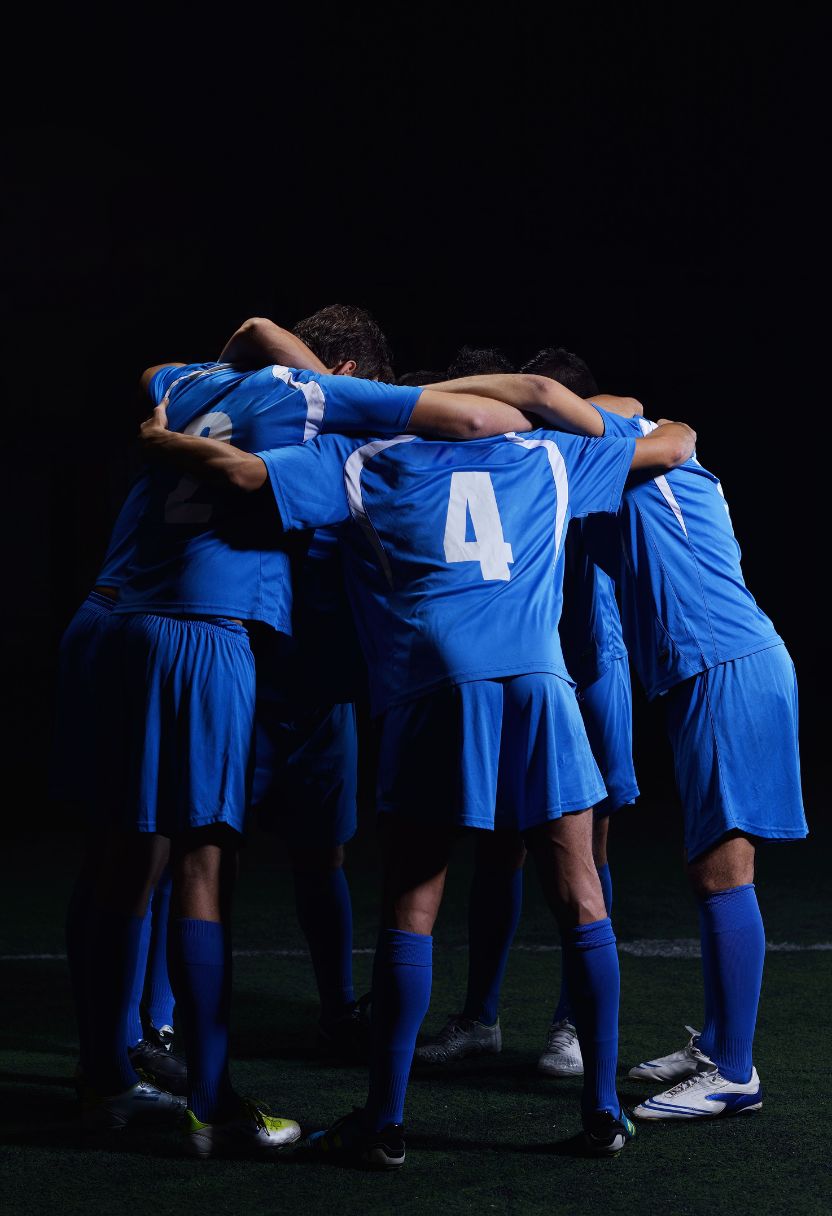

Leadership in team sports ain't just about the person wearing the captain's armband or shouting instructions on the field. It's a complex, multifaceted role that's crucial for any team's success. Leadership, at its core, involves guiding, motivating, and inspiring others to work towards a common goal. In team sports, this can mean the difference between winning and losing – not just in terms of scores but also in fostering a positive and cohesive team environment.
One might think that leadership is all about being loud and authoritative. But it's not! Get the scoop click that. Effective leaders know when to talk and when to listen. They understand their teammates' strengths and weaknesses and use that knowledge to bring out the best in everyone. A good leader isn't someone who bosses people around; they're someone who earns respect through their actions both on and off the field.
The importance of leadership can't be overstated. Obtain the inside story click on this. Without it, teams often lack direction and purpose. Leaders help set goals, create strategies, and keep everyone focused during tough times. They're like the glue that holds everything together when things start falling apart (which they inevitably do). And let's face it – every team faces challenges, whether it's dealing with losses or managing conflicts within the group.
Another aspect that's often overlooked is how leaders inspire confidence. When players believe in their leader's vision and trust their decisions, they're more likely to give their best effort. This kind of mutual trust creates a strong bond among teammates that's hard to break.
But hey, no one's perfect! Leaders make mistakes too – they're human after all. What's important is how they handle those mistakes: owning up to them rather than shifting blame shows humility and builds credibility.
In conclusion (oops, I almost did it again), leadership roles are indispensable in team sports for steering the ship through calm waters as well as stormy seas. They ensure that every player feels valued while keeping everyone's eyes on the prize: working together towards victory or overcoming obstacles as one unified entity.
So yeah, don't underestimate the power of good leadership in sports – it's got way more impact than you might think!
Sure thing! Receive the scoop check that. Here it goes:
---
When we talk about leadership roles, it's really hard to ignore the key characteristics of effective team leaders. These traits are what make a leader not just good, but great. And no, we're not just talking 'bout being bossy or telling people what to do. Effective leaders have a whole bunch of qualities that set them apart from the rest.
First off, communication skills can't be overstated. A leader who doesn't communicate well is like a ship without a rudder; they're going nowhere fast! It's not just about talking either-listening is equally important. An effective leader listens to their team members' concerns and ideas. They don't dismiss anyone's input because they know that sometimes the best ideas come from the most unexpected places.
Then there's empathy. You'd think it's all about getting the job done, but nope! Great leaders show genuine care for their team's well-being. They understand that everyone has off days and personal issues to deal with. By showing empathy, they build trust and loyalty within their team. This isn't something you can fake; people can spot insincerity from a mile away!
Another characteristic is decisiveness. Sure, nobody likes making tough decisions, but an effective leader knows when to bite the bullet and make a call. Procrastination ain't gonna get you anywhere in leadership roles. But hey, it's also important for them to be flexible enough to change course if things aren't working out as planned.
Let's not forget integrity either! No one respects a leader who's dishonest or unreliable. An effective team leader stands by their word and leads by example. If they expect high standards from their team, they've gotta hold themselves to those same standards too.
However, confidence shouldn't be confused with arrogance-there's a fine line between the two! Good leaders are confident in their abilities and decisions but remain humble enough to acknowledge mistakes and learn from them.
Lastly-and this might seem obvious-but motivation matters big time! A leader who's passionate about their work inspires others around them automatically (well almost). They know how to keep morale up even when times are tough.
So yeah, these key characteristics might sound simple on paper but putting them into practice? That's where the real challenge lies. Not every leader gets it right all the time – they're human after all! But striving towards these qualities makes all difference between merely managing a group of people and leading an inspired team ready tackle anything thrown at 'em!
In conclusion (oh wait did I just say finally?), there ya go-the essential traits that define effective team leaders in today's world!
---
Hope this fits your needs!
Transforming an average team into champions might sound like a daunting task, but it’s not impossible.. Sports techniques have been time-tested and proven to turn the ordinary into extraordinary.

Posted by on 2024-07-08
Continuous Improvement and Adaptation
When it comes to mastering the art of team dynamics, one thing's for sure: you can't expect perfection overnight.. It ain't gonna happen.

Posted by on 2024-07-08
The Role of Coaches and Leaders in Fostering a Collaborative Environment
In team sports, the importance of teamwork and communication can't be overstated.. Without these elements, even the most talented athletes would struggle to find success.

Posted by on 2024-07-08
Coaching styles can dramatically influence team performance, and there's no shortage of case studies that highlight successful implementations.. By looking at different approaches, we get a clearer picture of what works and what doesn’t.

Posted by on 2024-07-08
The Role of Captains and Coaches in Team Dynamics
When it comes to team dynamics, the roles of captains and coaches can't be overstated. They are at the heart of a team's success or failure, sometimes without even knowing it themselves. Sure, players' skills matter, but it's the leadership that truly shapes how those skills get used.
First off, let's talk about captains. These individuals ain't just there to wear an armband or toss a coin at the start of a game. They're like the glue that holds everyone together on and off the field. A good captain will know when to push their teammates hard and when to ease up. They'll navigate through conflicts with other players and keep spirits high during tough times. It's like being a big brother or sister; you gotta know when to tease and when to support.
Coaches, on the other hand, have a slightly different role but it's no less critical. They are not just there to shout instructions from the sidelines-although they do plenty of that! A coach must understand each player's strengths and weaknesses, creating strategies that make use of everyone's talents. And hey, they're also motivators who can turn around losing streaks by just saying the right words at half-time.
Interestingly enough, neither captains nor coaches work in isolation; they need each other more than you'd think. The best teams often have captains who can translate a coach's vision into action on the field or court. If there's disconnect between them? Oh boy, that's where problems start piling up real quick.
It's worth noting that both roles involve making some pretty tough decisions now and then-and not everyone will be happy about 'em either! Sometimes a captain has to bench their best friend for someone else who's performing better at practice. Or a coach might decide on a risky strategy that doesn't sit well with everybody initially but could pay off big time later.
Captains are usually chosen because they've earned respect through performance and attitude over time whereas coaches typically come with credentials and experience already under their belts (or whistles). Yet both need continuous learning; none can afford complacency if they wish for sustained success within any competitive environment.
So while anyone might think all eyes should always be on star players dribbling balls down courts or scoring goals-it's really these unsung heroes managing things behind scenes steering ships towards victory shores!
In conclusion: Captains provide everyday leadership among peers fostering unity & accountability whilst Coaches offer overarching strategic direction combining tactical insight w/ emotional intelligence ensuring cohesive teamwork achieving common objectives efficiently effectively despite inevitable setbacks along way proving indispensable pillars underpinning robust resilient dynamic triumphant sporting entities everywhere!!


Developing leadership skills among athletes is a crucial undertaking that extends benefits far beyond the playing field. Leadership roles, when embraced by athletes, contribute to their personal growth and significantly influence team dynamics and performance. The process of nurturing these skills involves fostering qualities such as communication, responsibility, empathy, and resilience.
Athletes often find themselves in situations where quick decision-making and effective communication are essential. These scenarios provide fertile ground for developing leadership capabilities. By encouraging athletes to take on leadership roles-whether as captains, mentors to younger teammates, or organizers of team activities-they learn to articulate strategies clearly and motivate others effectively. This not only enhances their own confidence but also fosters a cohesive team environment where everyone feels valued and understood.
Responsibility is another cornerstone of leadership that athletes can develop through their sports involvement. Being accountable for one's actions on the field translates into better decision-making skills off it. For instance, an athlete who consistently demonstrates punctuality, discipline in training, and a strong work ethic sets a powerful example for peers. This kind of role modeling helps inculcate a sense of duty within the entire team, leading to higher standards of collective behavior and performance.
Empathy plays a pivotal role in effective leadership; understanding teammates' perspectives can lead to stronger bonds and improved collaboration. Athletes who show compassion towards one another create an atmosphere of mutual respect and support. This quality becomes particularly important during challenging times-such as after losses or injuries-where empathetic leaders can help maintain morale and encourage perseverance.
Resilience is yet another vital trait developed through athletic endeavors that contributes to robust leadership abilities. Sports inherently involve facing setbacks and overcoming obstacles. Athletes who learn to bounce back from defeats with renewed determination set an inspiring precedent for their peers. Their ability to handle pressure gracefully serves as an invaluable lesson in maintaining composure under stress-a skill transferrable to any area of life.
In conclusion, promoting leadership roles among athletes equips them with indispensable life skills while enhancing team cohesion and performance. Through practicing effective communication, embracing responsibility, demonstrating empathy, and cultivating resilience, athletes become well-rounded individuals capable of leading both on the field and beyond it. Investing effort into developing these attributes ensures that sports serve not just as physical pursuits but also as arenas for profound personal development.
The Impact of Leadership on Team Performance and Morale
Leadership ain't just about giving orders. It's about inspiring, guiding, and sometimes even learning from your team. A leader's role can have a huge impact on team performance and morale – for better or for worse.
Firstly, let's talk about performance. Good leaders often know how to bring out the best in their team members. They're not always telling people what to do but instead, they're showing them how it's done. When a leader sets clear expectations and provides the necessary support, teams tend to perform better. They feel more confident in their roles because they know there's someone who believes in them and has got their back.
However, it ain't all sunshine and rainbows. Poor leadership can drag a team's performance down faster than you can say "disaster." If a leader is constantly micromanaging or failing to communicate effectively, it creates confusion and frustration among team members. Nobody likes feeling like they're being watched over every second or left in the dark about what's happening. This kind of environment stifles creativity and productivity.
Now, onto morale – which is just as important as performance if you ask me! A good leader knows that happy employees are productive employees. When leaders show appreciation for hard work and encourage a positive work-life balance, it boosts morale significantly. People want to come to work when they feel valued; it's as simple as that.
But again, bad leadership can really mess things up here too. Leaders who don't acknowledge their team's efforts or who create a toxic work environment through favoritism or negativity are pretty much guaranteed to kill morale. And once that's gone? Well, good luck getting those folks motivated again.
It's also worth mentioning that leadership isn't one-size-fits-all. Different situations might require different styles of leadership – flexibility is key! Some teams might flourish under an authoritative leader while others might do better with someone who's more democratic.
In conclusion (not trying to sound too formal here), the impact of leadership on team performance and morale can't be overstated enough - it's massive! Great leaders lift their teams up; poor ones drag them down into the mud.. So if you're in any sort of leadership position right now?, take some time to reflect on how your actions are affecting those around you.. Your team's success could very well depend on it...
Examples of Successful Leaders in Various Team Sports
When it comes to leadership roles in team sports, there's no denying that certain individuals stand out. These leaders not only excel on the field but also inspire their teammates to perform at their best. Let's take a look at a few examples from different sports.
Firstly, Michael Jordan is often regarded as one of the greatest basketball players of all time. But he wasn't just a phenomenal player; he was an exceptional leader too. He didn't let his team slack off and always pushed them to strive for greatness. Jordan's leadership wasn't about being bossy or domineering; rather, it was about setting an example with his work ethic and determination.
Next up, we have Tom Brady in American football. Brady has led his teams to numerous Super Bowl victories and is known for his incredible ability to stay calm under pressure. He isn't just a quarterback; he's a motivator who knows how to get the best out of each player around him. His leadership style might not be loud or flashy, but it's effective nonetheless.
In soccer, Lionel Messi stands out as another remarkable leader. Though not typically vocal, Messi leads by example through his extraordinary skills and relentless effort on the pitch. He doesn't demand respect with words – oh no – his actions speak louder than any speech ever could.
Switching over to cricket, MS Dhoni from India is worth mentioning. Dhoni's cool demeanor under stressful situations earned him the nickname "Captain Cool." He's known for making sharp decisions that have led India to numerous wins in international tournaments. Dhoni isn't someone who panics easily; instead, he instills confidence in his teammates.
Lastly, Serena Williams in tennis demonstrates individual leadership that's impactful even without a traditional 'team.' While tennis is largely an individual sport, doubles matches require coordination and mutual trust between partners. Serena's fierce competitiveness and encouraging nature make her a standout leader when she plays doubles alongside her sister Venus or other partners.
So there you have it! Leadership in sports can manifest itself in many ways – through inspiring performance like Jordan, calm decisiveness like Dhoni or quiet consistency like Messi. What unites all these leaders though? They don't just play their game; they elevate everyone else's too!
Leadership in team sports environments is no walk in the park. It's fraught with challenges that can trip up even the most seasoned leaders. A leader ain't just someone who calls the shots; they've got to be a mentor, a motivator, and sometimes, even a friend. Let's dive into some of these hurdles they face.
First off, one of the most glaring issues is dealing with diverse personalities. Teams are made up of individuals from different backgrounds, and each person has their own way of doing things. You can't expect everyone to see eye-to-eye all the time, right? So, it's on leaders to navigate these differences and foster an environment where everyone feels valued but also part of a cohesive unit.
Another tricky challenge is managing expectations - both their own and those of the team members. Everybody wants to win, obviously! But not every game will end in victory. Leaders must strike a balance between pushing their team to perform at its best while also keeping morale high when things don't go as planned. It's not easy walking that fine line without occasionally stumbling.
Communication breakdowns can also throw a wrench in the works. Clear communication is key for any successful operation, yet misunderstandings still happen more often than you'd think. A leader might think they're being perfectly clear about strategy or feedback, only to find out later that half the team didn't get it. And boy, does that lead to chaos!
Moreover, there's always pressure coming from all sides – fans expecting wins, management demanding results, and players needing support. It's like juggling flaming swords while riding a unicycle! Leaders have gotta prioritize what's important without dropping the ball (or getting burned).
On top of everything else, there's this thing called burnout. The constant stress can take its toll not only on players but on leaders too! They're supposed to be pillars of strength but guess what? They're human beings who need breaks and support systems just like anyone else.
In conclusion (though far from exhaustive), leading in a team sports environment isn't just about having tactical knowledge or making decisions during crunch time; it's about people skills – understanding them and inspiring them despite numerous hurdles along the way. It ain't easy by any means but when done right-it's incredibly rewarding!